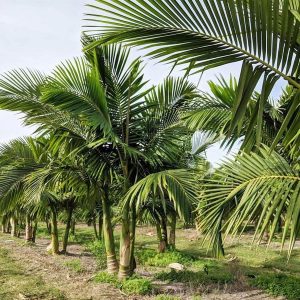Types of Palm Trees
Fun fact – palm trees are not trees. Instead, they can be classified as woody perennials, pretty much like bamboo. All types of palm trees belong to the Aceraceae family. However, the distinction between palm trees and bamboo is quite stark. Palm trees do not just belong to different species; some even belong to different genera. The genetic makeup of palm trees is as diverse as they come.
 At Palmco, we have a diverse range of palm tree varieties in different shapes and sizes. Before you can buy palm trees, it is essential to understand their identities to distinguish between the varieties. Here are just a few of our favorites.
At Palmco, we have a diverse range of palm tree varieties in different shapes and sizes. Before you can buy palm trees, it is essential to understand their identities to distinguish between the varieties. Here are just a few of our favorites.
Although this palm tree is sometimes referred to as Florida royal or Cuban royal palm, it has no connections between its name and origin. A native of Mexico, the royal palm can grow in hardiness zones 10 and 11. It can grow to more than 100 feet with a mature spread of about 20 feet. It is advisable to grow young royal palm trees in some shade.
Mature royal palm trees feature light grey trunks with minimal texture. With time, large feathery leaves develop from the trunk of the royal palm. This plant usually does not have an excessive number of leaves. However, the few leaves that grow on the plant can be up to 15 feet long with bushy leaflets. Royal palm grows well in neutral to slightly alkaline soils and requires lots of moisture.
Native to the Australian outback, Foxtail palm is extremely popular throughout the world, especially in the U.S., where it is used as a landscaping plant. Many people find it difficult to distinguish between foxtail palm and royal palm because of their similar features. Although royal palm can grow to a height of about 100 feet, foxtail palm can only grow to about 50 feet. Most foxtail palms reach a height of about 30 feet. The name of this plant stems from its large sets of feathery leaves resembling a fox’s tail. Foxtail palm grows well in hardiness zones 9, 10, 11, and 12. They do well with partial or complete sun exposure and slightly acidic to neutral soils. Foxtail palm has moderately high moisture requirements.
This palm tree grows either as a shrub or a small tree and can reach 15 feet. In addition, it features multiple trunks of the same size. The trunks of fan palm trees take on textured appearances as they grow. At Palmco, our team can recommend tips to prevent your fan palm from suckering, allowing it to grow as a single stem. Fan palm leaves have many divisions, creating many sharp points on their foliage. Native to Europe, the fan palm grows in hardiness zones 9-11 with full or partial sun exposure. In addition, this plant has minimal moisture requirements.
At Palmco, we understand how difficult it can be to identify different palm tree varieties. Fortunately, palm, mast, and bamboo trees are our specialties, and we can help you make clear distinctions between the palm trees you want for your landscaping project. In addition, we can help you choose specific palm tree varieties that do well in your area.
Please contact Palmco today at (239) 283-1329 to learn more about the different types of palm trees on our Pine Island, FL plantation.

